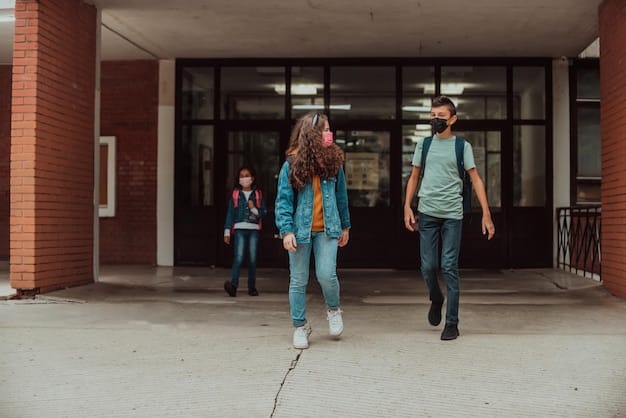Understanding the School-to-Prison Pipeline: Racial Disparities and Solutions

The school-to-prison pipeline denotes the disproportionate tendency of students from disadvantaged backgrounds, particularly students of color, to face harsh disciplinary measures in schools, funnelling them into the juvenile and criminal justice systems.
The school-to-prison pipeline is a disturbing trend impacting communities across the United States, disproportionately affecting students of color and those with disabilities. Understanding its causes and consequences is the first step towards dismantling this harmful system.
What is the School-to-Prison Pipeline?
The school-to-prison pipeline isn’t a physical structure, but rather a set of policies and practices within schools that contribute to students ending up in the juvenile justice system. It’s a complex issue rooted in systemic inequality and often fueled by zero-tolerance policies.
These policies, while intended to create safer school environments, often lead to suspension, expulsion, and even arrest for minor infractions. This can disrupt a student’s education, increase their likelihood of dropping out, and ultimately, increase their chances of becoming involved with the criminal justice system.
Zero-Tolerance Policies and Their Impact
Zero-tolerance policies are a major contributor to the school-to-prison pipeline. These policies mandate specific consequences, often harsh ones, for a wide range of misbehavior, regardless of context or a student’s individual circumstances.
Their rigid application removes teacher and administrator discretion, leading to disproportionate punishment for minor offenses that previously would have been handled within the school.
- Increased suspensions and expulsions for non-violent offenses.
- Reduced opportunities for restorative justice and conflict resolution.
- Disproportionate impact on marginalized student populations.
This inflexibility can push students out of the classroom and onto a path toward the juvenile justice system.
Racial Disparities in School Discipline
The school-to-prison pipeline disproportionately affects students of color, particularly Black and Hispanic students. Data consistently shows that these students are more likely to be suspended, expelled, and arrested in school than their white peers, even for similar offenses.
Understanding the root causes of these disparities is essential to addressing the larger problem of the school-to-prison pipeline and ensuring fair treatment for all students.

Implicit Bias and Its Role
Implicit bias, or unconscious stereotypes, can play a significant role in disciplinary decisions. Teachers and administrators, often unknowingly, may perceive behavior differently based on a student’s race, leading to harsher punishments for students of color.
This bias can manifest in various ways, from interpreting a student’s tone of voice as disrespectful to assuming malicious intent where none exists.
- Unconscious stereotypes influencing perceptions of behavior.
- Differential treatment based on perceived “threat levels.”
- Lack of cultural understanding leading to misinterpretations.
Addressing these implicit biases through training and awareness programs is crucial to creating a more equitable school environment.
The Role of Socioeconomic Factors
Socioeconomic factors also contribute significantly to the school-to-prison pipeline. Students from low-income families often face challenges that impact their behavior and academic performance, making them more vulnerable to disciplinary action.
These challenges can include food insecurity, housing instability, lack of access to healthcare, and exposure to violence. These stressors can lead to behavioral issues that are then addressed through punitive measures instead of supportive interventions.
Impact of Poverty on Student Behavior
Poverty creates a cycle of disadvantage that extends into the classroom. Students dealing with the stressors of poverty may exhibit behavioral problems that are often misinterpreted and punished.
Schools in low-income communities are often under-resourced, lacking the staff and programs needed to support students facing these challenges effectively.
- Increased stress and anxiety leading to behavioral outbursts.
- Lack of access to mental health services and support.
- Under-resourced schools unable to provide necessary interventions.
Addressing the underlying socioeconomic factors that contribute to the school-to-prison pipeline requires a holistic approach that includes investing in communities and providing support services for families.
Alternatives to Zero-Tolerance Policies
Moving away from zero-tolerance policies and embracing more restorative and supportive approaches is essential to dismantling the school-to-prison pipeline. These alternative strategies focus on addressing the root causes of misbehavior and creating a more positive school climate.
Restorative justice, trauma-informed care, and positive behavioral interventions are just a few examples of alternative approaches that can help keep students in school and out of the justice system.
Restorative Justice Practices
Restorative justice emphasizes repairing harm and building relationships rather than simply punishing offenders. It involves bringing together those who have been harmed with those who caused the harm to discuss the impact of the offense and develop a plan to make amends.
This approach promotes accountability, empathy, and healing, creating a more positive and supportive school environment.
- Focus on repairing harm and building relationships.
- Emphasis on accountability and empathy.
- Reduced rates of suspension and expulsion.
Restorative justice practices can create a more equitable and just school environment for all students.
Trauma-Informed Care in Schools
Many students, particularly those from marginalized communities, have experienced trauma that can impact their behavior and academic performance. Trauma-informed care recognizes the effects of trauma and incorporates this understanding into all aspects of school life.

This approach involves creating a safe and supportive environment where students feel comfortable sharing their experiences and seeking help.
Creating a Supportive School Environment
A trauma-informed school prioritizes building relationships, fostering resilience, and providing access to mental health services. It also involves training staff to recognize the signs of trauma and respond in a sensitive and supportive manner.
By creating a more supportive and understanding school environment, trauma-informed care can help students heal from trauma and succeed academically.
- Building strong relationships between students and staff.
- Providing access to mental health services and support.
- Training staff to recognize and respond to trauma.
This approach can help to reduce disciplinary issues and keep students engaged in their education.
Advocacy and Policy Changes
Addressing the school-to-prison pipeline requires systemic change that goes beyond individual schools. Advocacy and policy changes are crucial to creating a more equitable and just education system.
This includes advocating for policies that reduce reliance on zero-tolerance discipline, increase investment in mental health services, and promote restorative justice practices.
Community Involvement and Advocacy
Community involvement is essential to driving policy change. Parents, students, educators, and community organizations must work together to advocate for policies that support students and dismantle the school-to-prison pipeline.
This can involve organizing rallies, contacting elected officials, and sharing personal stories about the impact of the school-to-prison pipeline.
- Engaging parents, students, and community members in advocacy efforts.
- Supporting organizations working to reform school discipline policies.
- Raising awareness about the school-to-prison pipeline through public education campaigns.
By working together, communities can create a more just and equitable education system for all students.
| Key Aspect | Brief Description |
|---|---|
| 🚨 Zero Tolerance | Policies leading to suspensions and expulsions for minor offenses. |
| 🧑🤝🧑 Racial Disparities | Students of color are disproportionately affected by disciplinary measures. |
| 🛡️ Alternatives | Restorative justice and trauma-informed care can reduce suspensions. |
| 📣 Advocacy | Community involvement is crucial for policy changes and awareness. |
Frequently Asked Questions
▼
The root cause is a combination of zero-tolerance policies, racial bias, and lack of resources in schools, leading to disproportionate discipline for students.
▼
Students from low-income families often face challenges that impact behavior and academic performance, making them more vulnerable to disciplinary action.
▼
Restorative justice focuses on repairing harm, building relationships, and promoting accountability rather than simply punishing offenders.
▼
Trauma-informed care recognizes the effects of trauma and incorporates this understanding into all aspects of school life, fostering a safe environment.
▼
Communities can advocate by engaging parents, supporting reform organizations, and raising awareness through public campaigns and contacting elected officials.
Conclusion
Addressing the school-to-prison pipeline requires a multi-faceted approach that includes reforming school discipline policies, addressing racial bias, investing in mental health services, and engaging communities in advocacy efforts. By working together, we can create a more equitable and just education system that supports all students.





